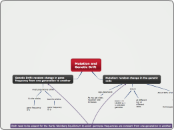Global Warming
Phenology
Phenological change: change in the timing of life cycle event
such as plants and flowering time
Biological Impacts
Species Extinctions
tropical frogs
Coral bleaching
warming and acidification
Earlier Spring events
Altitudinal/poleward shift in species ranges
Tropical Diseases with Global Warming
Dengue
Filariasis
Schistosomiasis
Malaria
Greenhouse Effect
leads to warmer global temperatures
Physical environmental changes
warming oceans
more intense hurricanes
melting Arctic ice and glaciers
rising sea levels
change in precipitation
reduction of heat lost into atmosphere due to greenhouse gases
which are CO2, methane, and nitrous oxide
Population Regulation
Epidemics
Black Plague in 1348
killed almost all in England
FOOD
Primary regulator of human population
Biological Control Techniques of agricultural pests
by hormones
pheromone traps to control insect pests
by reproductive control
release of sterile male insects
by parasites, predators, or pathogens
prickly pear cacti regulated by cactoblastis
Environmental Resistance
Decrease population size
emigration
adverse weather conditions
Density Independent Regulator
insufficient living space
competition
predation
diseases
insufficient nutrients, food, or water
Biotic Potential
Increase population size
defense mechanisms
ability to withstand adverse conditions
rate of reproduction
Human Evolution
Diversification of Language
parallels with the human evolutionaly process
like new species, it arose in isolation accumulating more and more differences over time
The brain size
is heritable
Strong selection for brain size
Intelligence is an adaptation
as a result of
Natural Selection
increased dramatically
Australopithecus afarensis
Homo habilis
Homo erectus
Neanderthal men
Modern humans
evolved about 50,000 - 35,000 years ago
lived between 150,000 - 30,000 years ago
spread out of Africa to Europe and Asia
lived between 2.5 - 1.5 million years ago
this species was a toolmaker
is the common ancestor of other Australopithecus species
Extinction
The fewer the population, the more vulnerable it goes to extinction
Getting rid of diversity
Major causes of contemporary extinction
Habitat Destruction
Hunting
Species Introduction
Diseases
Genera longevity is longer than species longevity
Mass Extinction
Factors of Mass Extinction
Volcanic Activity
Asteroid Hits
Consequences of asteroid hit
Terrible tremor
million times greater than the strongest tremor recorded in human history
Killer waves
Tsunamis as high as 300 feet
Choked sky
little sunlight penetrates to the ground for several months
Into Orbit
the explosion launches into orbit at 50 times the speed of sound
can be traced by rock signature
such as Iridium
65 million years ago, nearly all dinosaurs went extinct
Selection
Sexual Selection
Males compete, females choose
Artificial Selection:
breeder (an individual) is selecting
Natural Selection:
Environment is selecting
Directional selection
The mean shifts to either side
Disruptive selection
Stabilizing selection
Intermediates have an advantage
Response to Selection
Changes in the mean from one generation to another
which depends on both
Selection Differential
it measures the intensity or strength of selection
Heritability
it is a proportion of the phynotypic vatiation that is genetically based
Differential Reproduction
means
Given phenotype is giving more or less offsprings as other penotypes
Mutation and Genetic Drift
Genetic Drift: random change in gene frequency from one generation to another
most populations either
lose the alleles
gene frequency of 0
fix the alleles
gene frequency of 1
Mutation: random change in the genetic code
About 95% of all mutations are harmful
which are
Homozygous mutations
Age-dependent
As you get older, mutation rate increases
occurs
at different loci at different rates
every 1 in 10,000 to 1 in 100,000 gametes

